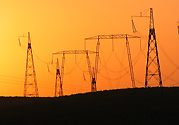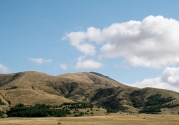In a rapidly growing region, strained and aging energy facilities call for new investments
| KEY TOPICS: Energy Security, G8 Summit, World Bank Projects, Russia, South East Europe Energy Community, Turkey, Gas, Renewable Energy, Hydroelectric Power, Sangtuda, Tajikistan |
 Washington DC, 10 July 2006 - At a time of rising oil prices and uncertainty over gas supplies, energy security has been given star billing at this month’s Group of 8 industrial nations summit in St Petersburg, Russia. Last year’s summit at Gleneagles focused on clean energy and climate change. Washington DC, 10 July 2006 - At a time of rising oil prices and uncertainty over gas supplies, energy security has been given star billing at this month’s Group of 8 industrial nations summit in St Petersburg, Russia. Last year’s summit at Gleneagles focused on clean energy and climate change.
Beyond the high-level communiqués, the World Bank has been working steadily with countries in Eastern Europe, Turkey and the Former Soviet Union, as well as in other parts of the world, to develop sound energy strategies. Giving people access to clean, reliable and efficient energy has been a World Bank priority for many years. Approximately 20% of the World Bank’s Europe and Central Asia portfolio is invested in the energy sector. Europe and Central Asia is ripe for substantial investments and change. Many economies in the region were built on cheap energy from the Soviet Union. Energy inputs had no real market value – and were consumed with little concern for the economy or the environment. Today, as energy prices rise and Russia is set on receiving market prices for the gas it supplies to its neighbors, questions of energy efficiency and diversification are more pressing then ever. Although energy consumption dropped as economies contracted after the fall of communism in the 1990s, rapid growth across Europe and Central Asia (ECA) is now straining energy resources and making new investments crucial to sustain economic development and improve the region’s environmental record. The World Bank currently has 41 active energy projects under supervision in ECA representing about US$ 2.7 billion in credits and loans. Several projects stand out in terms of their scope and reach.  An integrated energy market in South East Europe An integrated energy market in South East Europe
-A billion-dollar program to support the coordinated transmission and trade of energy across nine countries in South East Europe is the most ambitious World Bank initiative in recent years.
The Energy Community of South East Europe includes Albania, Bosnia and Herzegovina, Bulgaria, Croatia, FYR Macedonia, Romania, Serbia, Montenegro and Turkey (Kosovo and the EU member states of Austria, Greece, Hungary, Italy and Slovenia are also involved.) The program, approved in 2005, offers an opportunity to improve the security of electric power supplies across the region, lower costs and bolster economic development. The Bank estimates that meeting the growing demand for electricity in South East Europe would require about US$ 40 billion over the next 15 years in power generation, transmission and distribution investments. The hope is that private investors will meet some of these needs once South East Europe becomes a financially-attractive EU-compatible energy market. Regional integration is expected to minimize the costs of energy supply and increase its reliability. (Recent investment climate assessments in the region have shown that the low reliability of power supplies is a major concern for private businesses.) Imports of low-cost power from Russia and Ukraine could also address the demand for power in South East Europe once transmission networks are properly strengthened and connected. “Promoting integration with the Western European energy market is the overarching theme of our work in places like South East Europe and Ukraine,” says Peter Thomson, the World Bank’s Director for Infrastructure in Europe and Central Asia. Reliable and renewable energy in Turkey -In Turkey, the Bank is supporting several innovative projects that should bolster the reliability of energy supplies. A gas storage project currently underway aims to build a buffer stock in a country dependent on Iran and Russia for gas. Although industrialized countries typically store 15 to 20% of their annual demand for gas, Turkey has no such reserves. This critically-needed gas storage facility will also help Turkey meet the winter peak in household gas demand as cities move away from more polluting coal-based heating. A US$ 200 million renewable energy loan, approved in 2004, seeks to reconcile environmental concerns and economic interests by making private investments in renewable energy production in Turkey financially possible. Private sponsors of geothermal, wind and hydro power projects are given access to long-term credits which help them overcome some of the traditional hurdles that stand in the way of these investments and compete favorably in Turkey’s energy market. Unlocking Tajikistan's Hydropower Potential -Further east, the Bank is exploring the possibility of reviving Tajikistan’s vast hydroelectric potential to supply electricity to South Asia by stringing high voltage transmission lines across Afghanistan. In the former USSR, hydropower was a byproduct of the irrigation system linking Central Asian republics. Mountainous republics like Tajikistan and Kyrgyzstan traded water for fossil fuels with downstream republics like Kazakhstan. When the Soviet Union collapsed, so did these synergies, and an ambitious regional hydro project was dropped. Tajikistan’s Sangtuda hydroelectric power plant, which was 20% completed by the early 1990s when financing stopped, is now receiving the attention of a Russian utilities company (RAO UES of Russia) and several international financial institutions including the World Bank.
 Improving the Region's Environmental Record Improving the Region's Environmental Record -Much of the Bank's investment funding is going towards the rehabilitation and upgrading of energy facilities dating back to the 1960s and 1970s. A by-product of these investments is an improvement in efficiency with associated beneficial environmental impacts. Countries in the Former Soviet Union are still some of the least efficient energy users measured in terms of GDP per unit of energy used.
Through its Prototype Carbon Fund, the Bank is also helping countries identify financing opportunities for clean energy technologies through the sale of carbon credits. * * * |
